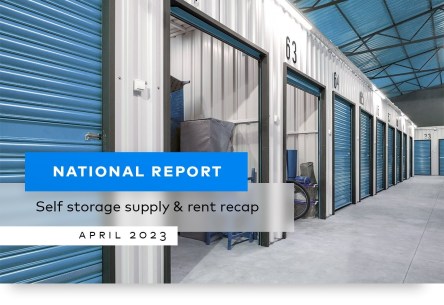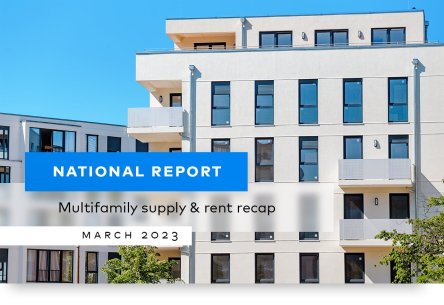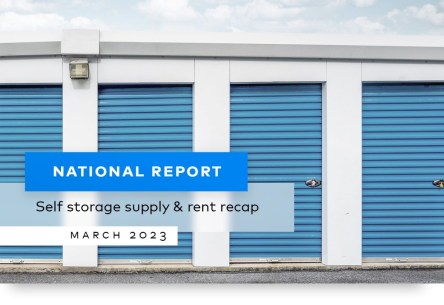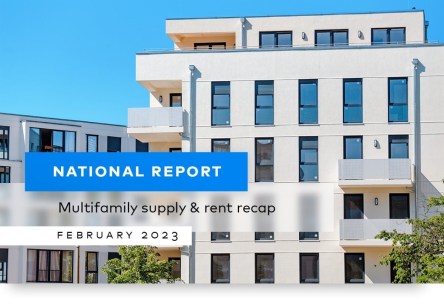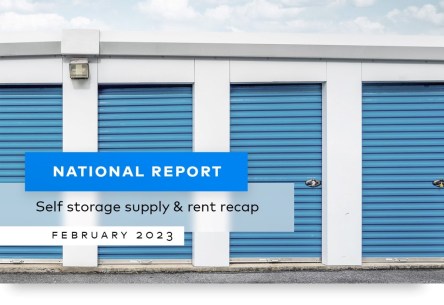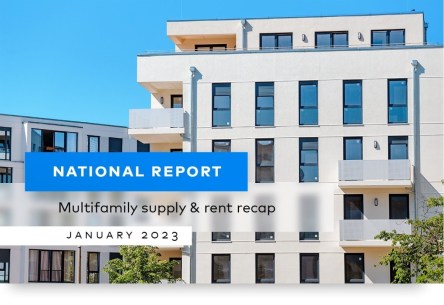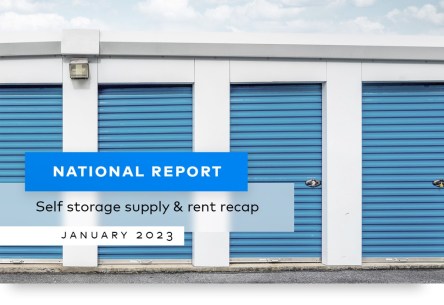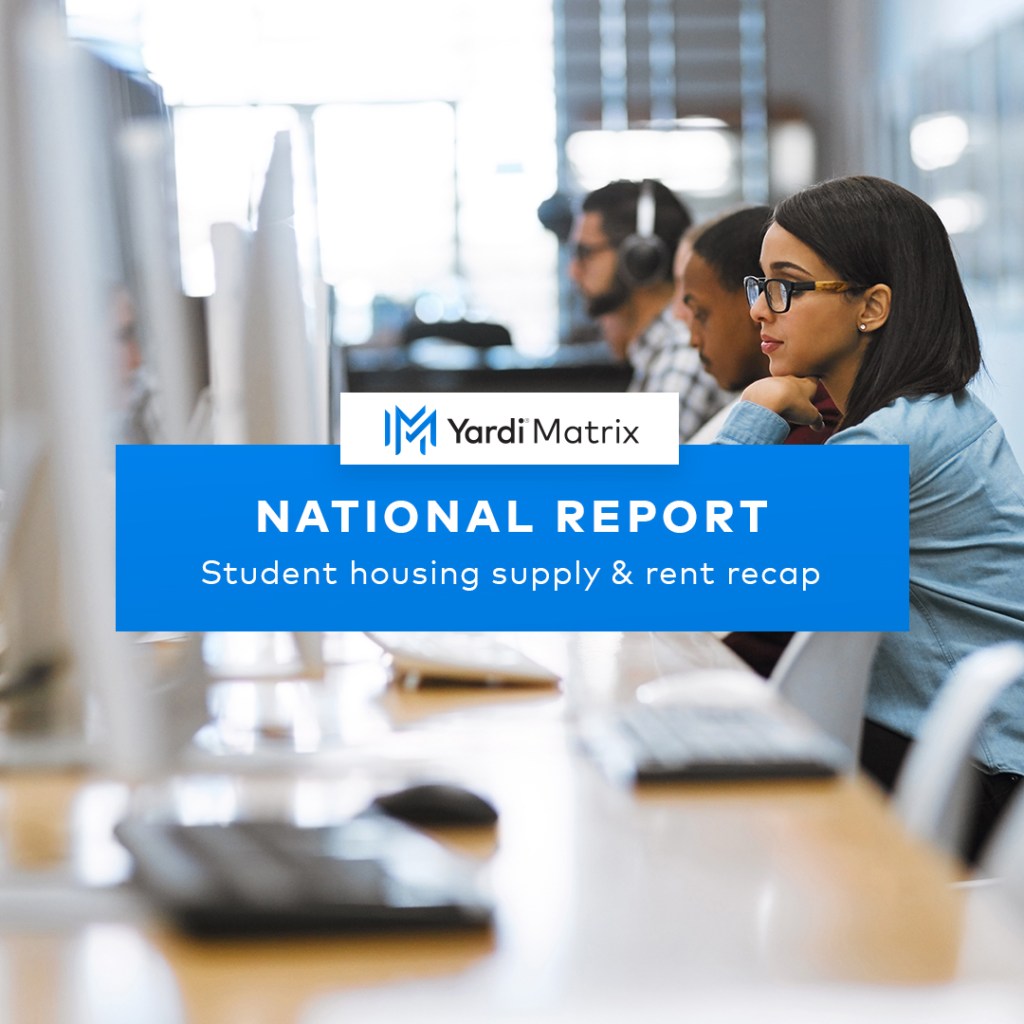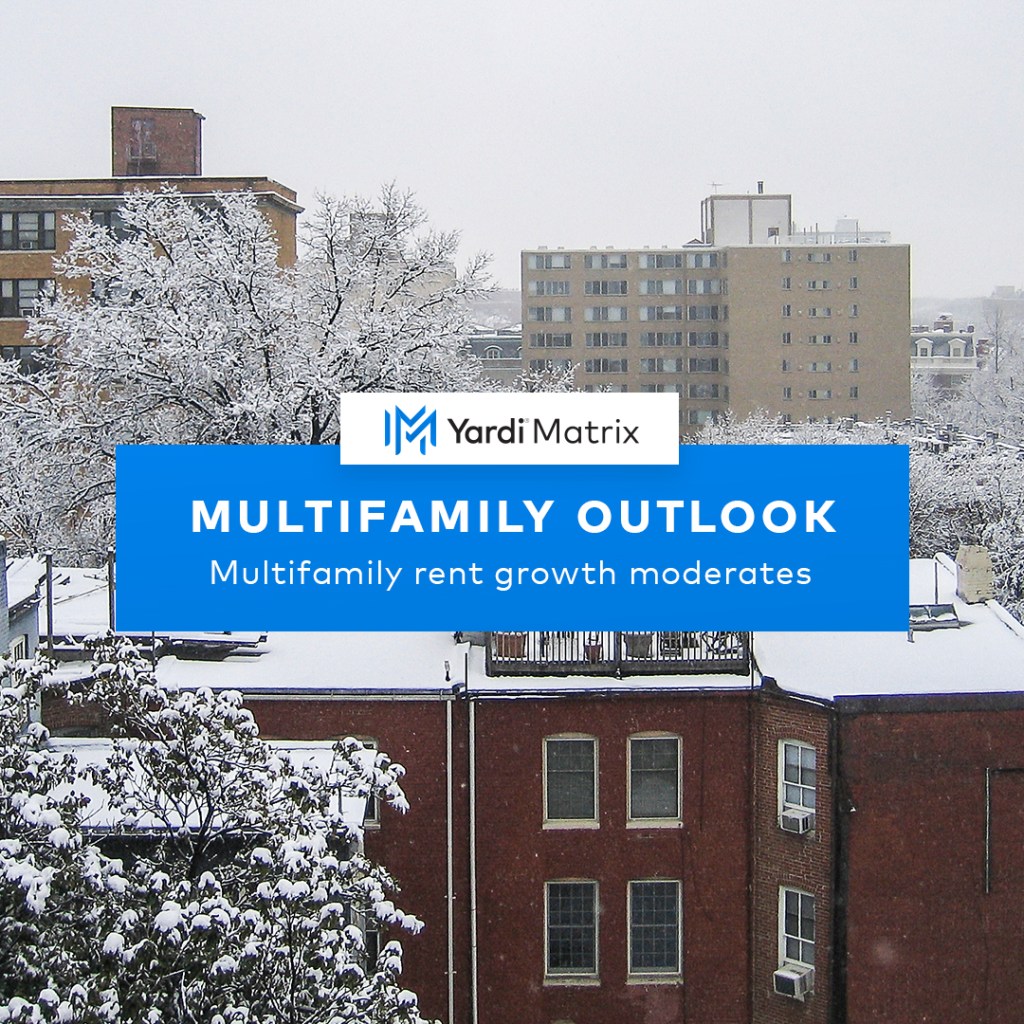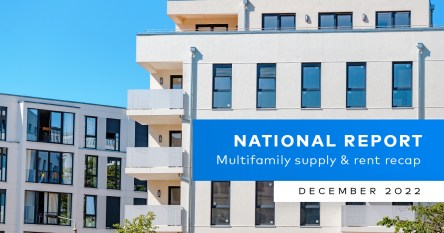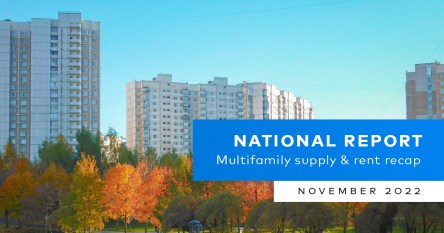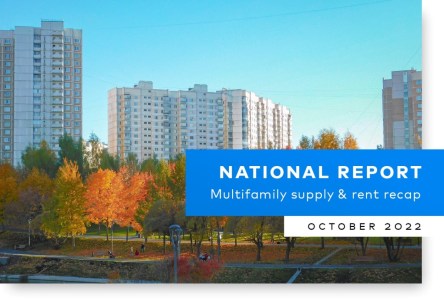As the student housing sector continues to outperform other real estate classes during a time of economic uncertainty, tailwinds from the multifamily market and consolidation of the higher education landscape are driving strong performance. Those were two key takeaways from the latest Yardi Matrix market update, which took place this week and featured insights from Jeff Adler, vice president of Yardi Matrix, and Ron Brock, industry principal. If you missed the webinar, a session recording and the presentation deck is available now. Student housing demonstrated record preleasing as of March, with rent growth averaging 7 percent across all university types tracked by Matrix. Less expensive unit types, such as 3-bedrooms, are picking up a higher share of the preleasing inventory, indicating that more students than ever are returning to campus post-pandemic. “From an operations standpoint, preleasing season has crushed it this year,” Adler stated. “Fundamentals seem to be tied to increasing enrollment at the most competitive schools, which are the winners in the ongoing consolidation of the higher education system.” The Yardi Matrix student housing data set includes over 1.3 million beds at 2,500 universities and colleges nationwide, including the top 200 investment grade universities across all major collegiate conferences. Known as the “Yardi 200,” it includes all Power 5 conferences as well as Carnegie R1 and R2 universities. The top 50 largest universities are forecasted to have the most enrollment growth over the next five years, confirming consolidation of the higher education space. Adler began forecasting the anticipated consolidation in a Fall 2021 webinar and the trend continues to evolve, but is reflected in high demand for preleasing at colleges in urban areas and with multifamily shadow markets. In a notable demonstration of the trend, Southeastern Conference (SEC) schools logged the most annual rent growth of any Yardi 200 conference at 11 percent. “This is influenced by significant run ups in rents in the conventional multifamily sector – in and around the cities where the SEC schools are located,” noted Adler. “The tailwind coming from the multifamily sector has a significant effect on operating results.” That includes schools like the University of Arkansas, University of Mississippi and University of Tennessee, which were among the top performers for rent growth and preleasing growth over the last quarter. Other key takeaways from the presentation included: Deliveries of new student housing stock dipped in 2022 but are expected to rebound this year. Transaction activity has slowed due to higher interest rates. Investors backed off of purchases dramatically in Q1 2023, with only $148 million in sales completed, down substantially from the $1.5 billion recorded in the first quarter of 2022. Significant development and transaction activity may not take place until 2025/2026 after the economy improves and interest rates are lower. California is not the only state experiencing significant shortages in student housing. That’s also taking place in Florida (Florida Atlantic University, Florida A&M), at the University of Arkansas, the University of Tennessee and the University of Cincinnati. Florida is a hot spot for student housing development, with over 12,000 bedrooms under construction around four universities. Bottom line, the student housing sector is one of the hospitable places for investors these days, even with the economy in flux. “Student housing is in the best position compared to other real estate asset types because of continued high performance,” Adler said. “There are multiple paths for investment in student housing, there isn’t just one way to succeed.” Learn more about the student housing market conditions from the latest Yardi Matrix National Student Housing report, released...
Self Storage Rents
Still negative on annual basis
Self storage street rates continue to fall off of last year’s historic highs each month, according to the latest National Self Storage Report from Yardi® Matrix. However, sector fundamentals remain strong. Year-over-year street rate growth was negative in March for the sixth straight month, with national average rates for standard-size 10×10 units down 2.3 percent year-over-year for non-climate-controlled (NON CC) units at $127 and 3.4 percent for climate-controlled (CC) units at $142. “Although street rates are negative on an annual basis, rates remain relatively steady sequentially, with some unit types and sizes registering increases on a month-over-month basis,” say Matrix analysts. “Operators largely remain optimistic about demand despite the volatility in the financial markets because storage performance has repeatedly proven to be stable during times of economic volatility.” Most of Yardi Matrix’s top 31 metros recorded negative street rate growth last month compared to March 2022. Year-over-year, rates for 10×10 NON CC units were again negative in the majority of the top metros, with 25 experiencing decreases. Nashville was the only metro with positive YOY rate growth in March for both 10×10 NON CC and CC units, and the only city tracked without a drop in rates for CC units. Learn more about the state of the self storage sector nationwide. Yardi Matrix tracks a total of 4,735 self storage properties nationwide in various stages of development — including 817 under construction, 1,896 planned and 656 prospective properties. Matrix also maintains operational profiles for 29,299 completed self storage facilities across the United States, bringing the total data set to 34,034. Yardi Matrix offers the industry’s most comprehensive market intelligence tool for investment professionals, equity investors, lenders and property managers who underwrite and manage investments in commercial real estate. Yardi Matrix covers multifamily, student housing, industrial,...
Rents Rise
According to Yardi Matrix
Multifamily asking rents rose slightly last month as demand stayed strong despite economic challenges, according to the new National Multifamily Report from Yardi Matrix. The average U.S. asking rent rose $3 in March to $1,706. Year-over-year growth fell to four percent nationally, 90 basis points less than February and the lowest level since rents started an unprecedented climb in April 2021. Single-family rental rates increased in March by $5 to $2,079, while the year-over-year increase fell by 80 basis points to 2.8 percent. “The first quarter produced no gains for multifamily rents for the first time in a decade, but the results come as somewhat of a relief,” say Matrix experts. “Multifamily demand held up well despite the attention given to the Federal Reserve-induced economic slowdown, bank failures and the deceleration from the outsize rent gains of the last two years. Rents and occupancy are stable as the market heads into the growth season.” Rents and the national occupancy rate were unchanged during the first quarter of 2023, and 21 of the top 30 Matrix metros recorded rent gains in March. Gain more insights by downloading March’s Multifamily Report. Yardi Matrix offers the industry’s most comprehensive market intelligence tool for investment professionals, equity investors, lenders and property managers who underwrite and manage investments in commercial real estate. Yardi Matrix covers multifamily, student housing, industrial, office and self storage property types. Email [email protected], call (480) 663-1149 or visit yardimatrix.com to learn...
Storage Stabilizes
Yardi Matrix Market Report
Self storage street rates were flat in February as consumer relocation trends and demand revert to pre-pandemic levels, according to the latest National Self Storage Report from Yardi Matrix. Growth of the average national street rate for all unit sizes was -2.8 percent year-over-year, unchanged from January. Rates for standard-size 10×10 units fell by 3.1 percent year-over-year for non-climate-controlled (NON CC) units and 4.1 percent for climate-controlled (CC) units. Despite lack of rate growth, the industry is in a comfortable position as the typically busy spring leasing season approaches. “Although fundamentals softened slightly in the fourth quarter owing to normal seasonal patterns and some customers balking at increasing rates, demand is strong and occupancy remains ahead of where it normally is this time of year,” states the report. “We’re seeing good demand from new customers coming into the system,” Public Storage’s chief financial officer, Tom Boyle, said recently. “Move-in volumes through the (winter) are up double digits.” Self storage-foused REITs are forecasting mid-single digit net operating income growth in 2023. Annual street rate growth continued to be negative for most of the top 31 metros in February. Only three of the top 31 Matrix self storage metros had a year-over-year increase in street rates for 10×10 NON CC units, while rates were negative in 25 of the top metros. Learn more about the state of the self storage sector nationwide. Yardi Matrix tracks a total of 4,730 self storage properties nationwide in various stages of development — including 823 under construction, 1,885 planned and 662 prospective properties. Matrix also maintains operational profiles for 29,221 completed self storage facilities across the United States, bringing the total data set to 33,951. Yardi Matrix offers the industry’s most comprehensive market intelligence tool for investment professionals, equity investors, lenders...
Rents Remain Flat
February Multifamily Report
Multifamily asking rents remained the same for a second straight month in February, at a national average rate of $1,702, according to the new National Multifamily Report from Yardi Matrix. As the economy continues to adjust in the post-pandemic period, year-over-year growth continued its ongoing decline. It is now 4.8 percent nationally, down 70 basis points from the previous month and its lowest level in nearly two years. Asking rent growth remains positive year-over-year in almost every major metro, but 23 of Matrix’s top 30 metros recorded negative growth over the last three months and 17 were negative in February. “Multifamily rents are playing a waiting game, as rents have essentially leveled over the seasonal winter slowdown,” state Matrix analysts, noting that February has historically recorded minor rent growth gains. “The big question is whether demand and rents pick up as normal in the spring. Demand has come down from 2021 levels, though it remains positive in most markets.” Average U.S. asking rents in the single-family rental market were also flat at $2,071. The year-over-year increase fell by 80 basis points to 3.4 percent, far below the 14.8 percent growth rate a year ago. “Near-term performance will hinge not only on demand-supply dynamics at the local level but affordability and the economy,” the report states. Gain more insights by downloading February’s Multifamily Report. Yardi Matrix offers the industry’s most comprehensive market intelligence tool for investment professionals, equity investors, lenders and property managers who underwrite and manage investments in commercial real estate. Yardi Matrix covers multifamily, student housing, industrial, office and self storage property types. Email [email protected], call (480) 663-1149 or visit yardimatrix.com to learn...
Climate Costs Climb
For CRE Owners, Matrix Reports
A new Yardi Matrix Bulletin focuses on the rising cost of commercial property insurance, especially in climate-affected states like Florida and Texas. These increases are a growing problem for commercial property owners and beginning to threaten new development and property sales. Although rates are rising nationwide, the problem is most acute in states that are experiencing frequent extreme weather events like hurricanes, winter freezes and wildfires. Hurricane Ian, for example, resulted in over $50 billion in damages in Florida last September. Weather-related payouts have left some insurers insolvent, while others are avoiding high-risk states. This translates into higher rates and less coverage for property owners. “The rate environment for real estate-specific property is severely challenged, especially in Florida and Texas and along the Gulf Coast,” said Danielle Lombardo, the chair of Lockton Global Real Estate, a New York-based advisory firm. “This has caused a bifurcated market between catastrophe-exposed and non-catastrophe-exposed business, with the highest double-digit increases in properties that have negative risk attributes, such as older frames, a challenged loss history or undervalued assets.” Many reinsurance companies, which property insurers use to move portions of risk off their own balance sheets, are quitting high-risk states, and those that stay are raising rates by 45-100 percent. Lombardo said. “Reinsurers are running away from Florida,” she said. “Something has to be done differently.” Learn more in the new bulletin from Yardi Matrix. Yardi Matrix offers the industry’s most comprehensive market intelligence tool for investment professionals, equity investors, lenders and property managers who underwrite and manage investments in commercial real estate. Yardi Matrix covers multifamily, student housing, industrial, office and self storage property types. Email [email protected], call (480) 663-1149 or visit yardimatrix.com to learn...
Self Storage Slows
Yardi Matrix Webinar Recap
Fewer Americans are relocating, and that’s led to a period of stabilization, including rate declines and lessened transaction activity, for the self storage industry. Those were among the takeaways from a March 1 Yardi Matrix webinar presented by Jeff Adler, vice president of Yardi Matrix, and Paul Fiorilla, editorial director. You can view the session recording here. “Storage benefits from the movement of people, and the movement of people has moderated,” Adler stated. Other trends that led to record level demand for the sector in 2021 and the first half of 2022 were many millions of Americans working from home (WFH) for the first time, and the country’s aging population base. “WFH demand has been durable, but we’re not going to see a dramatic increase in it at this point,” Adler said, especially as many companies call workers back to the office at least some of the time. The self storage sector, typically a haven for savvy investors, experienced skittish investors last quarter. Despite recording its second-highest annual sales total in 2022, sales volume dropped sharply to close out 2022. Investment activity is expected to remain light in the near-term due to uncertainty in pricing and yields. Self storage property sales totaled $10.0 billion in 2022, down 18.7 percent from $12.3 billion in 2021 – which was the all-time high. “Despite the decline, sales activity was more than double any year prior to 2021. Institutional investor demand has grown in recent years, owing to the sector’s high returns relative to other property segments over the last two decades, recent strong fundamentals performance, and the prospects for growth,” says the latest Matrix Self Storage Transaction Bulletin. “This is a great sector. There’s really no question about the sector performance being poor. It’s been really good. It...
Demand Steady
For Self Storage
Continuing steady demand signals stability for the U.S. self storage sector even as street rates declined in January, according to the February 2023 National Self Storage Report from Yardi Matrix. Year-over-year street rates for 10X10 non-climate-controlled units slid by $7 to $126 in January, a 2.3% drop from their peak of $133 in the summer of 2022. Only five of the top 31 metros tracked by Matrix recorded rate growth in January. Despite this typical seasonal slowdown, “average street rates [for climate-controlled and non-climate-controlled units] remain healthy compared to historical levels,” the report says. The new-supply pipeline increased by 10 basis points month-over-month in January, accounting for 3.7% of completed inventory. In 2022, the number of households using self storage reached 14.5 million, an increase of about 970,000 since 2020. “As a result of the record demand, the self storage sector appears to be well-positioned to withstand potential economic headwinds in 2023,” according to the report. Get the latest on self storage supply, rent trends and more in the new Yardi Matrix report. Get even more details in a webinar on March 1. Yardi Matrix tracks 4,626 self storage properties nationwide in various stages of development. Matrix also maintains operational profiles for 29,072 completed self storage facilities, bringing the total data set to 33,698. Yardi Matrix offers the industry’s most comprehensive market intelligence tool for investment professionals, equity investors, lenders and property managers who underwrite and manage investments in commercial real estate. Yardi Matrix covers multifamily, student housing, industrial, office and self storage property types. Email [email protected], call 480-663-1149 or visit yardimatrix.com to learn...
Rents Hold
Yardi Matrix Market Report
Multifamily rents were flat in January as a strong jobs report indicated that fears of a significant economic recession may be overblown. U.S. asking rents averaged $1,701, unchanged from the prior month, according to the latest Yardi Matrix National Multifamily Report. Continuing late 2022 patterns, year-over-year growth continues to decline, and is now 5.5 percent, down 70 basis points from December. The single-family rental (SFR) market remained strong amid ongoing volatility in home sales. The average U.S. asking rent increased $1 in January to $2,070, while the year-over-year increase fell by 85 basis points to 4.2 percent. “Participants at the late January National Multifamily Housing Council conference in Las Vegas were generally optimistic about demand fundamentals, but concerns centered around issues such as the wave of proposed rent control measures, increasing expenses and high mortgage rates,” say Matrix analysts. However, the creation of 517,000 new jobs in January is a significant bright spot and help ease fears of an imminent economic downturn. The unemployment rate dropped to 3.4 percent last month and wage growth shows no signs of spiraling. “Concerns about a hard-landing recession that would reduce household formation are being alleviated by the continuing stellar performance of the job market,” states the report. Gain more insights by downloading January’s Multifamily Report. Last year, U.S. multifamily rents increased by 6.4 percent after peaking near 16 percent in 2021, according to Yardi Matrix. Those were record figures, the highest seen in a century. The 2023 Yardi Matrix Multifamily Outlook expects that rent growth will be closer to its historical average in 2023. Yardi Matrix offers the industry’s most comprehensive market intelligence tool for investment professionals, equity investors, lenders and property managers who underwrite and manage investments in commercial real estate. Yardi Matrix covers multifamily, student housing,...
Walkable Urbanism Rankings
Yardi Matrix Contributes Data
The nation’s top 35 metros are ranked on walkable urbanism using a newly released index that considers commercial rent premiums, multifamily rents, and for-sale home prices. For the first time, Yardi Matrix was a significant source of data for the report, which was co-authored by Michael Rodriguez, AICP, and Christopher B. Leinberger; and ultimately concludes that the demand for walkable urban real estate far exceeds supply. “Foot Traffic Ahead: Ranking Walkable Urbanism in America’s Largest Metros” finds that the top cities for walkability are: New York City Boston Washington, DC Seattle Portland San Francisco Chicago Los Angeles The rankings are based on the share of office, retail, and rental multi-family occupied square footage in walkable urban places relative to the metro region as a whole. “(The report) finds higher demand driving premiums for commercial and multifamily rents and for-sale home prices in walkable urban places, compared to car-dependent alternatives,” its authors conclude. According to Smart Growth America, the 2023 report required a different approach in methodology and analytics than in past years. That’s attributed to the pandemic. “Since the 2019 report, much of urban life has changed: the popularity of remote work skyrocketed; ever-increasing housing demand continued to push up the price of homes; public parks became invaluable social gathering spaces; and streets that once served only cars were shut down to make way for people,” SGA stated. “Taking these changes into account, FTA takes stock of the nation’s 35 largest metropolitan areas to identify how walkability in these places has transformed.” Among the interesting data points from the report: – Small spaces, significant population: Researchers found that 19.1 percent of the total U.S. real GDP and 6.8 percent of the U.S. population are located in walkable urban places that represent just 1.2 percent of total landmass of the top 35 U.S. metros. – Societal benefits: Walkable urban areas have the potential to improve community health by promoting physical activity, can reduce emissions by decreasing car use, and can advance equity via access to economic opportunity. –A mix of real estate product: Walkable urban places contain the highest concentration of office space (42.1 percent), just over one-third of multifamily rental spaces (30.4 percent), just under a quarter of retail space, and the smallest amount of for-sale housing (11.6 percent). –Lack of walkable urbanism creates community challenges: The report’s authors find that a walk of walkable places is directly connected to the U.S. affordable housing and cost of living crisis. “Housing in the very locations where it is most needed—such as transit-served and infill locations— remains challenging to deliver on account of restrictive zoning, lending policy, and pandemic-era supply chain and labor issues,” states the report. Check out the downloadable Foot Traffic Ahead report for more insights, and read additional coverage of the report and its impact on multifamily real estate from Multihousing...
Self Storage
Sees Seasonal Slowdown
National self storage street rates for all unit types continued to decline in December as the demand for housing dropped and seasonal trends took effect, according to the latest Yardi Matrix National Self Storage Report. National street rates for 10×10 non-climate-controlled (NON CC) units decreased 2.3 percent year-over-year in December to $126, a $7 drop from their summer peak. Rates for similar-size climate-controlled (CC) units fared slightly worse, dropping 3.4 percent year-over-year to $142, a $10 drop from the summer high. The decline in street rates in the last half of 2022 was expected due to normal seasonal slowdowns in demand, and overall rates remain healthy compared to historical levels. “Self storage had a strong year and is well-positioned heading into 2023. Street rates have declined, but operators have focused on increasing existing customer rents to achieve strong revenue growth, outweighing the rise in operating costs,” say Matrix experts. According to market research, operators remain confident in the resilient demand created over the past two years and the ability to backfill occupancy in the spring with higher-paying new customers. “A rapid rise in development costs, including the cost of debt, will also likely cause a deceleration in new supply in coming years, another positive for owners,” states the report. Learn more about the state of the self storage market nationwide. Yardi Matrix tracks a total of 4,627 self storage properties nationwide in various stages of development — including 1,789 planned, 812 under construction and 669 prospective properties. Matrix also maintains operational profiles for 29,032 completed self storage facilities across the United States, bringing the total data set to 33,659. Yardi Matrix offers the industry’s most comprehensive market intelligence tool for investment professionals, equity investors, lenders and property managers who underwrite and manage investments in commercial...
Student Housing
Expected to Outperform Again
The student housing industry is set up for another solid performance in 2023 after record returns last year, according to the latest National Student Housing Report from Yardi Matrix. “Momentum is strong heading into the new year, even as the effect of higher interest rates takes hold in the economy and has led multifamily rents to decelerate,” say Matrix experts. “Student housing remains largely unaffected, as the industry typically does better during times of economic volatility.” As of December 2022, 48 percent of beds at Yardi 200 universities were already leased for the fall 2023 school year, representing a new record high for this time of year. Rent growth also remained strong, at 4.7 percent annual growth. “With over eight months to go until the start of the next school year, we anticipate 2023 being another record-breaking year for student housing performance,” states the report. One caveat: highly selective universities with name recognition are maintaining their interest among incoming students, while smaller schools are having more difficulty with enrollment. The slowing economy is having an impact on new student housing supply. With interest rates increasing, the development pipeline is contracting. The development pipeline for Yardi 200 universities (including planned, prospective and under-construction properties) decreased by over 3,000 bedrooms from December to January, representing a 2.6 percent contraction. Gain more insight in the new National Student Housing Report. The student housing data set includes over 2,000 universities and colleges nationwide, including the top 200 investment grade universities across all major collegiate conferences. Known as the “Yardi 200,” it includes all Power 5 conferences as well as Carnegie R1 and R2 universities. Yardi Matrix covers multifamily, student housing, industrial, office and self storage property types. Email [email protected], call (480) 663-1149 or visit yardimatrix.com to learn...
Multifamily Outlook
From Yardi Matrix
Multifamily rent growth began to slow in late 2022 as economic pressures, including the impact of inflation, took root. The 2023 Multifamily Outlook from Yardi Matrix expects that rent growth will be closer to its historical average in 2023. Last year, U.S. rents increased by 6.4 percent after peaking near 16 percent in 2021, according to Yardi Matrix. Those were record figures, the highest seen in a century. The 2022 increase is expected to drop by half this year. “All eyes are on interest rates and how quickly inflation recedes. Economic growth will likely wane in the second half as the impact of rapid rate hikes take effect,” states the outlook. “This year we foresee rent growth dropping in half to 3.1 percent as demand lessens and deliveries remain high.” Demand is decreasing due to less renter migration, a dip in new household formation and declining affordability. Meanwhile new units are coming online nationwide. The forecast calls for 440,000 new deliveries in 2023, a stock increase of 2.9 percent. Deliveries will be concentrated in fast-growing markets, including Dallas, Austin, Charlotte, Nashville and Orlando. However, starts are expected to decline due to rising construction costs, a shortage of construction workers and planning/permitting delays. Gain more insights on the industry in the full report. Yardi Matrix offers the industry’s most comprehensive market intelligence tool for investment professionals, equity investors, lenders and property managers who underwrite and manage investments in commercial real estate. Yardi Matrix covers multifamily, student housing, industrial, office and self storage property types. Email [email protected], call (480) 663-1149 or visit yardimatrix.com to learn...
Asking Rents Fall
Multifamily Update
Multifamily asking rents recorded historic highs in 2022 but began to move south as the year concluded, recording another $4 drop to a national average $1,715 in December, according to the latest Yardi® Matrix National Multifamily Report. Year-over-year growth declined by 80 basis points to 6.2 percent last month, the lowest level since May 2021. Over the year, national asking rents recorded a 6.2 percent uptick, the second-highest annual growth in 100 years after 2021’s nearly 15 percent increase. But as the economy cooled in the fall and demand decreased, rents fell 0.2 percent in December and 0.6 percent in the fourth quarter. The single-family rental (SFR) market is also seeing slowing. National asking rates increased 4.8 percent year-over-year in December, which was a decrease of 100 basis points from November. SFR rents dropped by $8 to average $2,083 last month. “With a variety of concerns about the economy and affordability, we expect rent growth in 2023 will be closer to typical levels,” states the latest report. In 2023, Yardi Matrix expects asking rents should remain flat or fall slightly through the spring, when growth is normally strongest. Then rents will likely rise moderately, though nowhere near the dramatic levels of the last two years. Learn more in the latest Matrix National Multifamily Report. Yardi Matrix offers the industry’s most comprehensive market intelligence tool for investment professionals, equity investors, lenders and property managers who underwrite and manage investments in commercial real estate. Yardi Matrix covers multifamily, student housing, industrial, office and self storage property types. Email [email protected], call (480) 663-1149 or visit yardimatrix.com to learn...
Rents Drop
Yardi Matrix Multifamily Update
The anticipated slowdown in multifamily performance arrived last month, as the sector clocked its lowest year-over-year growth since mid-2021, according to the latest Yardi® Matrix National Multifamily Report. U.S. asking rents fell $9 during the month to $1,719, while year-over-year growth dropped to seven percent, the lowest level in 17 months. The decreases are attributed to economic headwinds and deteriorating demand. The $9 rollback was the largest one-month decline in rents in over a decade. The deterioration in rents was not unexpected. Rent increases have far exceeded normal growth patterns for nearly two years. Average asking rents increased by 22 percent nationally between January 2021 and October 2022, a rate that would be unsustainable under optimal conditions. “With the economy softening, demand for units slowing and rising interest rates creating head- winds for housing, multifamily asking rent growth finally took a turn downward in November,” states the report. “The decades-high inflation rate has left household balance sheets in a weaker position than a year ago, while economic growth is slowing as the Federal Reserve raises interest rates.” Absorption of apartments has been positive in 2022, but well below 2021 levels that were boosted by strong job growth and household savings coming out of the pandemic. Average U.S. rents are up 6.4 percent year-to-date, and the national occupancy rate, while slipping in recent months, is a healthy 95.6 percent. And while rent growth has turned negative in many metros this fall, every one of Matrix’s top 30 metros maintains positive year-over-year growth. The single-family rental market is also declining. The average U.S. asking rent dropped $5 in November to $2,091, while the year-over-year increase fell by 80 basis points to 5.9 percent. Learn more in the latest Matrix National Multifamily Report. Yardi Matrix offers the industry’s...
Yardi Matrix Multifamily Webinar
Sector outlook, anticipated recession and more
Yardi Matrix experts Jeff Adler and Paul Fiorilla presented their final 2022 outlook for the multifamily sector during a Nov. 16 webinar. As with most current economic forecasts, it’s a challenging picture despite recent record-setting performance and consistently strong fundamentals. The presentation materials and webinar recording are now available for download. According to the latest National Multifamily Report, average multifamily asking rents showed a slight increase in October, despite weaker demand and dipping year-over-year (YOY) growth. “The pandemic recovery has been rapid, it has been V-shaped, but now it is indeed cooling. We’re really on the downturn, is what I would tell you. The U.S. economy is slowing, the yield curve has inverted for all intents and purposes,” said Adler, vice president of Yardi Matrix. “When it comes to the U.S. multifamily industry, the domestic migration has had a significant impact on demand, but household formations have had even a larger impact,” Adler said. Demographic trends are expected to support continued housing demand. Rising interest rates, however, will preclude many would-be buyers from home purchases in the near future. First-time homebuyers are being frozen out of the market, according to the National Association of Realtors, and will be more likely to remain in rentals. “The capital markets are really what’s the problem, mortgage rates are up to 6 percent and above, and valuations have adjusted downward,” said Adler, off as much as 25 percent from a peak in January 2022. However, U.S. multifamily continues to be a standout sector among all asset types. “Declining homeownership will be a bit of a tailwind (for multifamily),” as long as household formation holds up, Adler said. “Fundamentals have been great, but they are decelerating.” U.S. asking rents increased $3 in October to $1,727. Year-over-year growth fell to 8.2 percent, the lowest level since the summer of 2021 and down from its 15.3 percent peak in the first quarter. The single-family rental market is also cooling off. The average U.S. asking rent was unchanged at $2,088 in October, while the YOY increase fell by 160 basis points to 6.6 percent. “SFR/BTR fundamentals are strong, but they’re also decelerating, very similar to multifamily,” Adler said. And with a difficult construction financing environment, limited new supply is expected through 2026. This could exacerbate the U.S. housing supply shortage, pushing it out through the next decade. As far as an anticipated recession, that’s currently very likely by the fourth quarter of 2023, according to experts. “Essentially we’re on a glide path to the next recession, which is probably one of the most well forecasted recessions I’ve seen in a while,” Adler observed. Learn more about Yardi Matrix’ wide variety of commercial real estate reports and...
Self Storage Update
From Yardi Matrix
National self storage street rates hit their lowest average of the year last month, according to the latest National Self Storage Report from Yardi Matrix. Average street rates for both 10X10 climate controlled (CC) and 10X10 non-climate controlled (NON-CC) units slipped in October for the second straight month as demand weakened. The national average rate in October was $145, the lowest in 2022 so far. The figure is a 0.7 percent decrease year-over-year (YOY). “Home sales, a major driver of storage demand, have slowed sharply in recent months as rising mortgage rates have made homebuying less affordable,” states the report. “What’s more, as inflation persists and a recession is increasingly likely, households are cutting expenditures on non-essential items such as storage.” Many operators are reducing street rates to maintain high levels of occupancy and looking for ways to cut costs in the event of an anticipated recession. Some operators are moving to remote facility management to reduce site staff and cut operating costs. For NON-CC units, only one of the top 31 Matrix-tracked metros had an annual street rate increase greater than five percent in October, while rates decreased in 11 of the top metros. For CC units, just one of the top 31 had five percent or more growth, while 21 metros registered negative rate growth YOY. Learn more about the state of the self storage market nationwide. Yardi Matrix tracks a total of 4,458 self storage properties nationwide in various stages of development — including 1,711 planned, 800 under construction and 604 prospective properties. Matrix also maintains operational profiles for 28,847 completed self storage facilities across the United States, bringing the total data set to 33,305. Yardi Matrix offers the industry’s most comprehensive market intelligence tool for investment professionals, equity investors, lenders and...
Multifamily Update
From Yardi Matrix
Average multifamily asking rents showed a slight increase in October, despite weaker demand and dipping year-over-year (YOY) growth, according to the latest Yardi® Matrix National Multifamily Report. U.S. asking rents increased $3 in October to $1,727. Year-over-year growth fell to 8.2 percent, the lowest level since the summer of 2021 and down from its 15.3 percent peak in the first quarter. The single-family rental market is also cooling from record-level performance. The average U.S. asking rent was unchanged at $2,088 in October, while the YOY increase fell by 160 basis points to 6.6 percent. The deceleration in asking rents is gradual, as all of the Matrix top 30 metros produced YOY rent increases. Experts are concerned about how the multifamily market will react to the rapid increase in short-term interest rates as the Federal Reserve attempts to reduce inflation. “The inevitable economic slowdown raises questions about when the impact will start to be felt and how much the sector will be affected,” states the report. “Demand has weakened since the first quarter due to slowing job growth and concerns over the macroeconomic environment. The robust household formation that drove demand in 2021 is no longer in effect.” The U.S. rental occupancy rate has dropped 50 basis points over the past year, but the national 95.5 percent rate remains above the long-term average. With debt costs higher and still rising, property sales and new construction have begun to slow. However, with home mortgage rates up to 7.3 percent as of early November, first-time homebuyers are being frozen out of the market, according to the National Association of Realtors, and will be more likely to remain in rentals. Learn more in the latest Matrix National Multifamily Report. Yardi Matrix offers the industry’s most comprehensive market intelligence tool...
Self Storage Slows
Yardi Matrix Reports
Year-over-year national street rates continued to tick up slightly in September, but month-over-month gains are now declining, according to the latest National Self Storage Report from Yardi Matrix. However, revenue growth remains strong as operators focus on boosting renewal rates. National street rates for 10×10 non-climate-controlled (NON CC) units increased 0.8 percent year-over-year in September, while rates for similar-sized climate-controlled (CC) units remained flat. The overall average street rate was up 0.7 percent, which is the slowest rate of annual growth for this category since July 2020. The national average rate for 10×10 NON CC units fell to $148 in September, not far below the all-time high of $152 reached in July. While the national average rate for similar-sized CC units dropped to $131, that figure was only $2 short of the record set this summer. Metros in the Southeast and Southwest continue to fare the best. For 10×10 NON CC units, only three of the top 31 Matrix-tracked self storage metros had street rate increases greater than five percent in September, while rates decreased in nine. For 10×10 CC units, none of the top 31 had five percent or more growth, while 13 metros experienced negative rate growth year-over-year. Learn more about the state of the self storage market nationwide. Yardi Matrix tracks a total of 4,306 self storage properties nationwide in various stages of development — including 1,649 planned, 769 under construction and 548 prospective properties. Matrix also maintains operational profiles for 28,798 completed self storage facilities across the United States, bringing the total data set to 33,104. Yardi Matrix offers the industry’s most comprehensive market intelligence tool for investment professionals, equity investors, lenders and property managers who underwrite and manage investments in commercial real estate. Yardi Matrix covers multifamily, student housing, industrial,...
Student Housing Earns High Marks
Record setting performance in 2022
The Yardi Matrix team continues to be bullish on the student housing sector following another stellar quarter of performance in Q3 2022. Jeff Adler, vice president of Yardi Matrix, delivered a glowing report card for student housing during a webinar last week. You can listen to the full recording here. “The sector is a great place to be over the next several years,” Adler said. “If you look across the entire landscape of asset types, student housing is extremely well positioned with exceptional offensive characteristics, as well as this gap between multifamily and student housing rents.” The gap means that there is a meaningful opportunity for additional student housing rent growth, particularly in urban markets, Adler explained. Multifamily rents jumped during the pandemic recovery, while student housing rent increases have not been as steep. According to the latest National Student Housing report: “The impact of multifamily rent trends on student housing will be stronger in university areas with a prominent shadow market, given the availability of options within a close radius.” Key highlights from Q3 performance include: Record-preleasing in advance of the 2022/23 school year, at 96.6 percent which was 2.3 percent higher than last yearPer-bedroom rents are 4.1 percent higher than a year ago, averaging $789 as of Sept. 2022Top tier universities received a surge in applicant interest and enrollment; however, less selective schools are struggling and there is an overall decrease in total students enrolledDeliveries of new student housing properties surged in 2022 These data points and many more are found in the new quarterly National Student Housing Report. The pace of preleasing was faster for selective universities with higher enrollment. But positive performance was widespread among university types across the country. Twelve universities had double-digit growth in pre-leasing levels in September compared to 2021, with Washington State University (18.9 percent growth) and the University of Houston (16.4 percent) topping the list. At some popular schools with growing enrollments, available student housing supply hasn’t been sufficient to house the incoming class. A problem that used to be unique to California schools has now become more widespread. Elevated investment activity continues despite rising interest rates, and the new-supply pipeline is robust. Nearly 45,000 new student housing bedrooms were delivered in 2022, accounting for 5.3 percent of Yardi Matrix-tracked housing stock. Matrix tracks 1.17 million off-campus student housing bedrooms at 2,065 properties across the...


